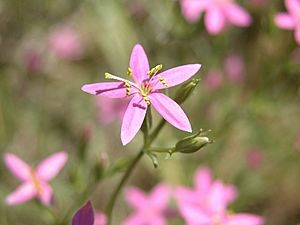Spring-loving centaury facts for kids
Quick facts for kids Spring-loving centaury |
|
|---|---|
 |
|
| Conservation status | |
| Scientific classification | |
| Genus: |
Zeltnera
|
| Species: |
namophila
|
| Synonyms | |
|
Centaurium namophilum |
|
The Zeltnera namophila, also known as the spring-loving centaury, is a very rare flowering plant. It belongs to the gentian family. This plant is special because it only grows in one specific area: the Amargosa Valley in Nye County, southwestern Nevada.
Where It Lives
This plant is found only in Ash Meadows. This area is part of the Amargosa Desert, located just east of Death Valley National Park. While it was once seen in California in 1978, no one has confirmed it growing there recently.
The spring-loving centaury loves to grow in moist and wet soils within the Ash Meadows wetlands. The soil in this area has a lot of clay and is very alkaline (high pH). It also has salts left behind as water evaporates in the desert air. You can find this plant in meadows where saltgrass grows. It also grows near streams, springs, and seeps (places where water slowly leaks out of the ground).
Other plants that grow in this unique area include Ash Meadows gumplant (Grindelia fraxino-pratensis), Emory baccharis (Baccharis emoryi), and Tecopa bird's beak (Cordylanthus tecopensis).
What It Looks Like
The Zeltnera namophila is an annual herb. This means it completes its entire life cycle, from seed to flower to seed, within one year. It grows a branching stem that can reach up to 45 centimeters (about 18 inches) tall.
This plant blooms during the hottest part of summer, usually from July to September. Its flower is about one centimeter (less than half an inch) wide. The petals are a deep pink color, with a touch of yellow inside the throat of the flower.
After blooming, the plant produces a fruit that is a small capsule. Each capsule holds about 50 tiny seeds. One plant can create many of these capsules. Scientists think it's a ruderal species. This means it can grow quickly in places where the ground has been disturbed, almost like a weed. Its many tiny seeds can spread easily and probably stay alive in the soil seed bank (seeds resting in the soil) for a long time.
Protecting This Plant
There are six main groups of this plant living in the Ash Meadows area. This includes nearby land managed by the Bureau of Land Management. Experts believe there are more than four million of these plants in total around the world. While this sounds like a lot, they are only found in these few spots. Before the 1960s, this plant was thought to be much more widespread across the area.
These remaining groups of plants are in danger. The biggest threat is changes to the water flow in the area, also known as hydrology. Water is a limiting factor for this plant, meaning it needs a certain amount of water to survive. The water table (the level of water underground) is dropping because of too much groundwater being pumped out. This is why the Zeltnera namophila is listed as a federally threatened species in the United States.
If conditions were perfect, this plant would likely be very common. It used to be widespread and can grow like a weed in many wet places. However, the ongoing loss of natural water in the area has limited its growth. It's not fully clear how much this has affected the plant. Other dangers include being trampled by wild horses (mustangs) and cattle grazing. Mining for clay minerals like bentonite, sepiolite, and saponite also poses a threat. Finally, invasive plants like yellow starthistle (Centaurea solstitialis) and saltcedar (Tamarix ramosissima) can take over its habitat. Luckily, workers at the refuge have been able to control these invasive plants.
Images for kids



